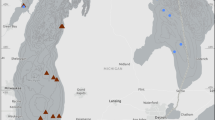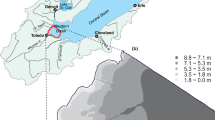Abstract
We quantified cover, population densities, size distribution and biomass of zebra mussels along 7 transects in eutrophic Lake Ekoln (Sweden). We also analyzed the elemental (C, N, P) composition of zebra mussel soft tissue and computed their retention rates of N and P their quantitative role in the lake’s nutrient budget. We hypothesized that zebra mussels play an important role in the nutrient budget of the lake and speculate that the successive harvesting of cultured mussels could contribute to the lake’s rate of recovery from cultural eutrophication. At depths exceeding 5 m, mussels covered consistently less than 5% or were absent. Similarly, mean densities were 3,158 ± 2,143 ind m−2 between 2 and 4 m, but rapidly declined at larger depths. Calculated clearance rates averaged 19.4 ± 2.3 km3 y−1, implying the entire lake is filtered every 8–10 days. Concentrations of N and P in mussel soft tissue averaged 100.9 ± 1.5 mg N g−1 DW and 9.3 ± 0.2 mg P g−1 DW. The lake population was estimated to 22.2 ± 2.6 × 1010 mussels, corresponding to a standing stock biomass of 362 ± 42 ton DW, or conservative estimates of 36.6 ± 4.3 ton N and 3.4 ± 0.4 ton P. Assuming a life span of 2–3 years gives a retention estimate of 1.2–1.8 ton P y−1 by mussels, corresponding to 50–77% of the annual P influx from Uppsala sewage treatment plant to the lake. Similarly, annual N-retention by zebra mussels makes up 13–20 ton N y−1, largely equaling the annual N-deposition from atmospheric sources on the lake’s surface. These retention rates correspond to only a few percent of the annual P-load from agricultural sources, but we argue that the quantitative role of zebra mussels in nutrient budgets is much larger if these budgets are adjusted for the bias introduced by coarse estimates of N and P pools that include a large share of refractory P.




Similar content being viewed by others
References
Ahlgren I, Frisk T, Kamp-Nielsen L (1988) Empirical and theoretical models of phosphorus loading, retention and concentration vs lake trophic state. Hydrobiologia 170:285–303
Arwidsson I (1926) Vandraremusslan (Dreissensia polymorpha Pallas) inkommen i Sverige. Fauna och Flora 21:209–217 [in Swedish]
Bastviken DTE, Caraco NF, Cole JJ (1998) Experimental measurements of zebra mussel (Dreissena polymorpha) impacts on phytoplankton community composition. Freshwater Biol 39:375–386
Berny PJ, Veniat A, Mazallon M (2003) Bioaccumulation of lead, cadmium, and lindane in zebra mussels (Dreissena polymorpha) and associated risk for bioconcentration in Tufted Duck (Aythia fuligula). Bull Environ Contam Toxicol 71:90–97. doi:10.1007/s00128-003-0135-9
Bruner KA, Fisher SW, Landrum PF (1994) The role of the zebra mussel, Dreissena polymorpha, in contaminant cycling: I. The effect of body size and lipid content on the bioconcentration of PCBs and PAHs. J Great Lakes Res 20:725–734
Caraco NF, Cole JJ, Strayer DL (2006) Top down control from the bottom: regulation of eutrophication in a large river by benthic grazing. Limnol Oceanogr 51:664–670
Chase ME, Baily RC (1999) The ecology of the zebra mussel (Dreissena polymorpha) in the lower great Lakes of North America: I. Population dynamics and growth. J Great Lakes Res 25:107–121. doi:10.1016/S0380-1330(99)70720-3
Connely N, O’Neill CR Jr, Knuth BA, Brown TL (2007) Economic impacts of zebra mussels on drinking water treatment and electric power generation facilities. Environ Manage 40:105–112. doi:10.1007/s00267-006-0296-5
Dzialowski AR, Jessie W (2009) Zebra mussels negate or mask the increasing effect of nutrient enrichment on algal biomass: A preliminary mesocosm study. J Plankton Res 31:1437–1440
Effler SW, Siegfried C (1998) Tributary water quality feedback from the spread of zebra mussels: Oswego, New York. J Great Lakes Res 24:453–463
Elliott P, Aldridge DC, Moggridge GD (2008) Zebra mussel filtration and its potential uses in industrial water treatment. Water Res 42:1664–1674. doi:org/10.1016/j.watres.2007.10.020
European Commission (2006) Setting maximum levels for certain contaminants in food stuffs. Commission regulation (EC) no 181/2006
Gergs R, Rinke K, Rothaupt K-O (2009) Zebra mussels mediate benthic–pelagic coupling by biodeposition and changing detrital stoichiometry. Freshwater Biol 1379–1391. doi:10.1111/j.1365-2427.2009.02188.x
Goedkoop W, Pettersson K (2000) Seasonal changes in sediment phosphorus forms in relation to sedimentation and benthic bacterial biomass in Lake Erken. Hydrobiologia 431:41–50. doi:10.1023/A:1004050204587
Grasshoff K, Ehrhardt M, Kremling K (1983) Methods of seawater analysis, 2nd edn. Verlag Chemie, Weinheim
Gren I-M, Lindahl O, Lindqvist M (2009) Values of mussel farming for combating eutrophication: an application to the Baltic Sea. Ecol Engg 35:935–945. doi:10.1016/j.ecoleng.2008.12.033
Håkanson L (1977) An empirical model for physical parameters of recent sedimentary deposits of Lake Ekoln and Lake Vänern. Vatten 3:266–289
Hallstan S, Grandin U, Goedkoop W (2010) Current and modeled potential distribution of the zebra mussel (Dreissena polymorpha) in Sweden. Biol Invasions 12:285–296. doi:10.1007/s10530-009-9449-9
Hieltjes AHM, Lijklema L (1980) Fractionation of inorganic phosphates in calcareous sediments. J Environ Qual 9:405–407
Josefsson M, Andersson B (2001) The environmental consequences of alien species in the Swedish lakes Mälaren, Hjälmaren, Vänern and Vättern. Ambio 30:514–521
Karatayev AY, Burlakova LE, Padilla DK (1997) The effects of Dreissena polymorpha (Pallas) invasion on aquatic communities in eastern Europe. J Shell Fish Res 16:187–203
Khalanski M (1997) Industrial and ecological consequences of the introduction of new species in continental aquatic ecosystems: The Zebra mussel and other invasive species. Bulletin Francais De La Peche Et De La Pisciculture 344–345:385–404
Królak E, Zdanowski B (2007) Phosphorus and calcium in the mussels Sinanodonta woodiana (Lea) and Dreissena polymorpha (Pall.) in the Konin lakes. Arch Polish Fish 15:287–294 [in Polish]
Larsson A (2005) Fyrisån 2004, Rapport om vattenkvalitet och närsaltstransporter (In Swedish). Fyrisåns vattenvårdsförbund, Uppsala kommun
Lindahl O, Hart R, Hernroth B, Kollberg S, Loo L-O, Olrog L, Rehnstam-Holm A-S, Svensson J, Svensson S, Syversen U (2005) Improving marine water quality by mussel farming—a profitable solution for Swedish society. Ambio 34:131–138
MacIsaac HJ (1996) Potential abiotic and biotic impacts of zebra mussels on the inland waters of North America. Am Zool 36:287–299
Mackie GL, Wright CA (1994) Ability of the zebra mussel, Dreissena polymorpha, to biodeposit and remove phosphorus and BOD from diluted activated sewage sludge. Water Res 28:1123–1130. doi:10.1016/0043-1354(94)90199-6
Mayer CM, Rudstam LG, Mills EL, Cardiff SG, Bloom CA (2001) Zebra mussels (Dreissena polymorpha), habitat alteration, and yellow perch (Perca flavescens) foraging: system-wide effects and behavioural mechanisms. Can J Fish Aquat Sci 58:2459–2467. doi:10.1139/cjfas-58-12-2459
Mellina E, Rasmussen JB, Mills EL (1995) Impact of mussel (Dreissena polymorpha) on phosphorus cycling and chlorophyll in lakes. Can J Fish Aquat Sci 52:2553–2573
Mills EL, Casselman JM, Dermott R, Fitzsimons JD, Gal G, Holeck KT, Hoyle JA, Johannsson OE, Lantry BF, Makarewicz JC, Millard ES, Munawar IF, Munawar M, O’Gorman R, Owens RW, Rudstam LG, Schaner T, Stewart TJ (2003) Lake Ontario: food web dynamics in a changing ecosystem, (1970–2000). Can J Fish Aquat Sci 60:471–490. doi:10.1139/F03-033
Naddafi R, Pettersson K, Eklöv P (2007) The effect of seasonal variation in selective feeding by zebra mussels (Dreissena polymorpha) on phytoplankton community composition. Freshwater Biol 52:823–842. doi:10.1111/j.1365-2427.2007.01732.x
Naddafi R, Pettersson K, Eklöv P (2008) Effects of the zebra mussel, an exotic freshwater species, on seston stoichiometry. Limnol Oceanogr 53:1973–1987
Nalepa TF, Hartson DJ, Fanslow DL, Lang GA, Lozano SJ (1998) Declines in benthic macroinvertebrate populations in southern Lake Michigan, 1980–1993. Can J Fish Aquat Sci 55:2402–2413. doi:10.1139/cjfas-58-3-518
Orlova MI (2002) Dreissena (D.) polymorpha: evolutionary origin and biological peculiarities as prerequisites of invasion success. In: Leppäkoski E, Gollasch S, Olenin S (eds) Invasive aquatic species of Europe: distribution, impacts and management. Kluwer Academic Publishers, Dordrecht, pp 127–134
Orlova M, Golubkov S, Kalinina L, Ignatieva N (2004) Dreissena polymorpha (Bivalvia: Dreissenidae) in the neva estuary (eastern Gulf of Finland, Baltic Sea): is it a biofilter or source for pollution? Mar Pollut Bull 49:196–205
Pimentel D, Lach L, Zuniga R, Morrison D (2000) Environmental and economic costs of nonindigenous species in the United States. Bioscience 50:53–65
Reeders HH, Bij de Vaate A (1990) Zebra mussels (Dreissena polymorpha): a new perspective for water quality management. Hydrobiologia 200/201:437–450. doi:10.1007/BF0253036
Riemann B, Simonsen P, Stensgaard L (1989) The carbon and chlorophyll content of phytoplankton from various nutrient regimes. J Plankton Res 11:1037–1045
Simon KS, Townsend CR (2003) Impacts of freshwater invaders at different levels of ecological organisation, with emphasis on salmonids and ecosystem consequences. Freshwater Biol 48:982–994. doi:10.1046/j.1365-2427.2003.01069.x
Sprung M (1993) The other life: an account of present knowledge of the larval phase of Dreissena polymorpha. In: Nalepa TF, Schloesser DW (eds) Zebra mussels: biology, impacts, and control. Lewis Publishers, Boca Raton
Strayer DL (1991) Projected distribution of the zebra mussel, Dreissena polymorpha, in North America. Can J Fish Aquat Sci 48:1389–1395
Vanderploeg HA, Liebig JR, Carmichael WW, Agy MA, Johengen TH, Fahnenstiel GL, Nalepa TF (2001) Zebra mussel (Dreissena polymorpha) selective filtration promoted toxic Microcystis blooms in Saginaw Bay and Lake Erie. Can J Fish Aquat Sci 58:1208–1221. doi:10.1139/cjfas-58-6-1208
Walz N (1978) The energy balance of the freshwater mussel Dreissena polymorpha Pallas in laboratory experiments and in Lake Constance. I. Pattern of activity, feeding and assimilation efficiency. Archiv für Hydrobiologie/Suppl 55:83–105
Wilander A, Persson G (2001) Recovery from eutrophication: experiences of reduced phosphorus input to the four largest lakes of Sweden. Ambio 30:475–485
Acknowledgments
We acknowledge Kalle Haikonen and Anna Lundqvist for submerged sampling, Markus Wallin for field assistance, and David Englund and Mirjam Goedkoop for assistance in measuring mussel lengths. This study was funded by the Swedish Environmental Protection Agency.
Author information
Authors and Affiliations
Corresponding author
Rights and permissions
About this article
Cite this article
Goedkoop, W., Naddafi, R. & Grandin, U. Retention of N and P by zebra mussels (Dreissena polymorpha Pallas) and its quantitative role in the nutrient budget of eutrophic Lake Ekoln, Sweden. Biol Invasions 13, 1077–1086 (2011). https://doi.org/10.1007/s10530-011-9950-9
Received:
Accepted:
Published:
Issue Date:
DOI: https://doi.org/10.1007/s10530-011-9950-9




